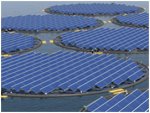With little land to spare, Singapore is looking to constructing floating solar farms to help supply electricity to the city-state.
According to an article on Fast Company, the Solar Energy Research Institute of Singapore has been tasked to design what will ultimately become the world’s largest floating solar farm; with an annual output of 3.3 – 4 gigawatt-hours of solar electricity.
The Institute’s efforts may be the biggest, but won’t be the first seen in Singapore in this regard. South East Asia’s first floating solar farm was constructed last year in the Pond Gardens of Singapore’s Bishan Park. That installation consists of 20 REC Peak Energy Series solar panels.
Elsewhere, other “floatovoltaics” installations we’ve reported on previously include Ciel et Terre’s Hydrelio, Synergy’s Floating Concentrating Photovoltaic (F-CPV) system, the Australian company constructing a floating solar farm in India, the “Floatovoltaics” concept by SPG solar and New Jersey American Water’s floating solar array.
In addition to generating electricity without taking up land, another bonus of floatovoltaics is it can reduce water evaporation – which could make it quite attractive to farmers in Australia looking to conserve dam supplies.
Within our own borders, the concept has been floated for implementation in South Australia. In May, GEITS ANZ Pty Ltd applied to the Essential Services Commission of South Australia for an electricity generation licence to operate a 400kW solar panel system to be situated at the Northern Areas Council Waste Water Treatment Plant in Jamestown.
Power from that facility would supply electricity to the plant and Morgan’s Sawmill initially, then possibly also to other customers in the township of Jamestown.
GEITS states some of its floating solar panel systems incorporate cooling, tracking and concentrators to maximize energy harvest, which can be up to 3 times that of traditional fixed based solar panels.
Image source: GEITS













































